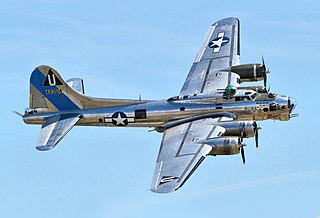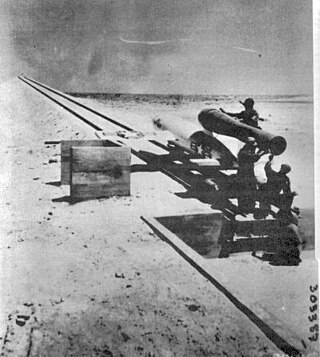
The Boeing B-17 Flying Fortress is an American four-engined heavy bomber aircraft developed in the 1930s for the United States Army Air Corps (USAAC). A fast and high-flying bomber of its era, the B-17 was used primarily in the European Theater of Operations and dropped more bombs than any other aircraft during World War II. It is the third-most produced bomber of all time, behind the American four-engined Consolidated B-24 Liberator and the German multirole, twin-engined Junkers Ju 88. It was also employed as a transport, antisubmarine aircraft, drone controller, and search-and-rescue aircraft.

Liberty Belle was a popular name for United States Army Air Forces (USAAF) aircraft during World War II; over two dozen known individual Boeing B-17 Flying Fortresses and Consolidated B-24 Liberators used the name.

|}

The Pink Lady is the nickname of a B-17G Flying Fortress bomber, serial number 44-8846, which flew several missions for the United States Army Air Forces (USAAF) over Nazi Germany near the end of World War II. The plane is now on static display in Cerny, Essonne, France.

Thunderbird was a high mission-tally Boeing B-17G Flying Fortress of the 303rd Bombardment Group during World War II. The original plane, serial number 42-38050, was scrapped at the end of the war and no longer exists. The name also appears on a later B-17G delivered at the end of the war, serial number 44-85718, which remains airworthy and is painted to replicate the earlier Thunderbird.

Nine-O-Nine was a Boeing B-17G-30-BO Flying Fortress heavy bomber, of the 323d Bombardment Squadron, 91st Bombardment Group, that completed 140 combat missions during World War II, believed to be the Eighth Air Force record for most missions without loss to the crews that flew her. A different B-17G, painted to mimic the Nine-O-Nine, crashed at Bradley International Airport in Windsor Locks, Connecticut, in October 2019.

Sally B is the name of an airworthy 1945-built Boeing B-17G Flying Fortress. At 79 years old, she is the only airworthy B-17 based in Europe, as well as one of three B-17s preserved in the United Kingdom. The aircraft is presently based at the Imperial War Museum Duxford, in eastern England. Sally B flies at airshows in the UK and across Europe as well as serving as an airborne memorial to the United States Army Air Forces airmen who lost their lives in the European theatre during World War II.

Shoo Shoo Shoo Baby, originally Shoo Shoo Baby, is a Boeing B-17 Flying Fortress in World War II, preserved and currently in storage at the National Museum of the United States Air Force, awaiting transfer to the Smithsonian's National Air and Space Museum. A B-17G-35-BO, serial number 42-32076, and manufactured by Boeing, it was named by her crew for a song of the same name made popular by The Andrews Sisters, the favorite song of its crew chief T/Sgt. Hank Cordes. Photographs of the bomber indicate that a third "Shoo" was added to the name at some point in May 1944 when the original aircraft commander completed his tour of duty and was replaced by another pilot.

Sentimental Journey (44-83514) is the nickname of a B-17G Flying Fortress bomber. It is based at the Commemorative Air Force Museum in Mesa, Arizona, US. The aircraft is regularly flown to airshows throughout North America.

Aluminum Overcast, B-17G-105-VE, s/n 44-85740, civil registration N5017N, as of August 2024 Aluminum Overcast is not flying. It is in the Eagle Hanger at the Experimental Aircraft Museum in Oshkosh,WI. It is awaiting wing spar repair. Boeing B-17 Flying Fortresses of the 46 complete surviving airframes in existence. It never saw combat, and it escaped the fate of many aircraft that were scrapped after World War II. It is owned by the Experimental Aircraft Association (EAA), and, as of 2022, it is still touring the United States and Canada offering flight experiences.

Texas Raiders was an American Boeing B-17 Flying Fortress, a B-17G-95-DL built by Douglas Long Beach. In 1967, it was purchased by the Commemorative Air Force's Gulf Coast Wing "Texas Raiders" group, which maintained and flew the aircraft out of Conroe-North Houston Regional Airport in Conroe, Texas. The aircraft was destroyed on November 12, 2022, by a mid-air collision with a P-63 Kingcobra at an air show at Dallas Executive Airport, Texas, that killed all five occupants and the P-63 pilot.

This is a list of United States Army Air Forces B-17 Flying Fortress units of the United States Army Air Forces, including variants and other historical information. Heavy bomber training organizations primarily under II Bomber Command in the United States and non-combat units are not included.
This is a partial list of accidents and incidents involving the Boeing-designed B-17 Flying Fortress. Combat losses are not included except for a very few cases denoted by singular circumstances. A few documented drone attrition cases are also included.

The 1st Experimental Guided Missiles Group is an inactive United States Air Force unit. It was last assigned to the Air Proving Ground Command and stationed at Eglin Air Force Base, Florida. It was inactivated on 22 July 1949.

Yankee Lady is a Boeing B-17 Flying Fortress, previously owned by the Yankee Air Museum of Van Buren Township, Michigan. Originally delivered to the U.S military in 1945, the plane did not see combat action; it was used by the United States Coast Guard for over a decade. Purchased by the museum in 1986, it has since been restored to a World War II configuration and is flown for flight experience rides and airshow appearances. The aircraft was sold to an unknown party in June 2024.

The 3205th Drone Group is a discontinued United States Air Force unit that operated obsolete aircraft during the 1950s as radio-controlled aerial targets for various tests. It was the primary post-World War II operator of surplus Boeing B-17G Flying Fortress aircraft, and also operated Lockheed F-80 Shooting Star and a few Boeing RB-47 Stratojet bombers that were converted into drone aircraft during the early years of the Cold War. It was last active with the Air Proving Ground Center, based at Eglin Air Force Base, Florida, where it was discontinued on 1 February 1961.

The 3225th Drone Squadron is a discontinued United States Air Force unit. It was last active with the Air Force Missile Development Center, based at Holloman Air Force Base, New Mexico. It was discontinued on 25 October 1963.

Boeing B-17G Flying Fortress No.44-83690 is a B-17 Flying Fortress heavy bomber currently undergoing restoration at the Museum of Aviation near Robins Air Force Base in Georgia. It was built as a B-17G-95-DL by the Douglas Aircraft Company and delivered for use on May 9, 1945. It was flown to Grissom Air Force Base for display as a museum piece in 1961. The plane was listed on the National Register of Historic Places in 1993. It was moved to the Museum of Aviation in August 2015.
















